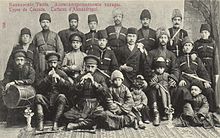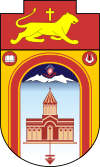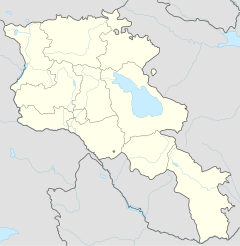Gyumri
|
Gyumri Գյումրի |
|||
|
|||
| State : |
|
||
| Province : | Shirak | ||
| Founded : | approx. 401 BC Chr. | ||
| Coordinates : | 40 ° 47 ' N , 43 ° 51' E | ||
| Height : | 1509 m | ||
| Area : | 36 km² | ||
| Residents : | 172,053 (2009) | ||
| Population density : | 4,779 inhabitants per km² | ||
| Time zone : | UTC + 4 | ||
| Telephone code : | (+374) 312 | ||
| Postal code : | 3101-3126 | ||
| Community type: | city | ||
| Mayor : | Samwel Balasanjan (independent) | ||
| Website : | |||
|
|
|||
Gyumri ( Armenian Գյումրի , traditionally Գիւմրի Giumri ;.. English and French transcription Gyumri ) is the second largest city of Armenia and the capital of the province of Shirak .
geography

Gyumri is located in the west of the country near the border with Turkey at about 1592 m .
Demographics
The city has about 130,000 inhabitants. Many of them speak a local Armenian dialect.
history

The place had been sporadically settled since ancient times. The present city originated from a Russian fortress founded in 1837. She shared the changing fortunes of Armenia. Until the First World War, it was the capital of a Ujesd in the governorate of Yerevan .
In the Russian Empire the city was called Alexandropol ( Александрополь , Ալեքսանրապոլ ) from 1840 to 1924 , then named after Vladimir Ilyich Lenin , from 1924 to 1991 Leninakan ( Russian Ленинакан , Լենինական ) and 1991/1992 Kumajri ( Կումայրի ).
On December 7, 1988 , a severe earthquake struck the Lori region in the north of the Armenian SSR, killing 25,000 people. In addition to the city of Spitak , which was almost completely destroyed, Leninakan and Kirowakan as well as many surrounding villages were badly damaged. Numerous, particularly non-socialist, countries took part in the reconstruction work. This is reflected in the diverse architecture of the new buildings, which often has features typical of the countries concerned.
education
Gyumri is home to two universities, the Shirak State University , founded in 1934 and named after Mikael Nalbandian (1829–1866), and the private Progress University , founded in 1990. In addition, several universities from Yerevan each have a campus in the city. These include the National Polytechnic University of Armenia , the State Conservatory , Hajbusak University , the Armenian State Economic University , the State Academy of Art , and the State Institute of Theater and Cinematography .
Culture and sport
About ten kilometers northwest of the city in the Achurjan valley are three churches from the 11th century of the former Marmaschen monastery .
The city is also home to the Armenian first division club FC Schirak Gyumri .
religion
The city has several intact churches, most of which belong to the Armenian Apostolic Church . It concerns u. a. around the Church of the Holy Sign ( St. Nshan ), built between 1852 and 1856, the Church of the Redeemer, built between 1859 and 1873, the Church of the Seven Wounds of the Holy Mother of God, built between 1874 and 1886, the Church of St. Grigor Lusaworitsch "from the 19th century, as well as the younger church" St. Hakob Mtsbinetsi "(2002), the chapel" St. Hripsime "(1991) and the chapel" St. Sargis "(2008).
Of the oldest church in the city, the Kumayri Basilica from the 7th century, only the foundations in the Botanical Garden are preserved.
In addition to the Armenian Apostolic Church, the Armenian Catholic Church also has a church presence in the city. The "Cathedral of the Holy Martyrs", built between 1852 and 1855, is still standing and is located on Haghtanaki Avenue, right next to the Museum of National Architecture.
In the south of the city the Russian Orthodox Church has the church "St. Arsenius, Archbishop of Serbia". The church "St. Nikolai the Miracle Worker" also exists as part of a Russian military cemetery. In 2009 the "St. Alexandra Martyrs Church" was inaugurated on Gjumri's Russian military site, which was built between 1837 and 1842 as part of the fortress of Alexandropol (Gyumri) and was destroyed in 1918 by Turkish troops.
The Jehovah's Witnesses are also present in Gyumri with at least one prayer hall ("Kingdom Hall"), as is the Church of Jesus Christ of Latter-day Saints (Mormons).
In 1926 an earthquake and between 1933 and 1934 the Soviets finally destroyed the church of the Greek Orthodox Church "St. George", which was located in Victory Park on the corner of Spandaryan Street and Haghtanaki Avenue . Other historic church buildings were also destroyed during the Soviet era.
economy
In the industrial sector, the city has carpet weaving and metal processing factories. Unemployment is high after the devastation caused by the 1988 Spitak earthquake .
It is planned to develop Gyumri into the IT center of Armenia. A Gyumri Technology Center has existed since 2014 , which aims to promote technological progress in the region, for example by training young people in programming.
Healthcare
The "Guest House Berlin" operated by the German Red Cross in Berlin is a specialty. After the earthquake of 1988, an association of various aid organizations from West Berlin was commissioned to build a polyclinic for medical care. A building on the main street was made available for this. Since the West German principle of a polyclinic encompasses both outpatient and inpatient care, an outpatient complex was also built for the most important medical subjects as well as a ward; the socialist variant of the outpatient clinic, however, provided for purely outpatient care, so this bed-keeping department was not needed. It was therefore decided to convert the rooms into a guest house. This improvisation developed out of the circumstances has meanwhile led to the fact that the outpatient medical operation can largely be carried out from one's own resources. In particular, in contrast to the other local medical facilities, investments in modern equipment technology are possible.
The therapy center Emili Aregak ("Emil's little sun") on the outskirts of Gyumri is the first Armenian facility that works with young people with disabilities according to modern standards.
traffic
Air traffic
Gyumri Airport , the second most important airport in the country, is located five kilometers south of the city center , and a base for the Russian armed forces on the western edge of the city .
Rail transport

The city has a large train station on the Tbilisi – Yerevan railway line .
Historically, Gjumri's importance in rail transport was greater. In 1899 the railroad reached the city with the Tbilisi – Kars line. In 1902 the railway to Yerevan , branching off from this line in Gyumri, was opened and the city became an important railway junction. As a result of the First World War , a new border was drawn between the Soviet Union and Turkey . The border now ran immediately west of Alexandropol , the next station in the direction of Turkey, Achurian , became the border station. In 1964 a three-rail track ( standard gauge , 1435 mm / Russian broad gauge , 1524 mm) between Kars (Turkey) and Leninakan was put into operation. Cross-border passenger traffic by rail was discontinued in 1988 and freight traffic in 1990. With the independence of Armenia in 1991 and the profound differences between Turkey and Armenia that followed, the transition was never reopened. In October 2017, the Kars – Akhalkalaki – Tbilisi – Baku railway line from Turkey, Georgia and Azerbaijan was opened as a bypass for Armenia in rail traffic.
Twin cities
Sister cities of Gyumri are
|
|
sons and daughters of the town
- Anania Schirakatsi (610–685), scholar, mathematician and geographer
- Georges I. Gurdjieff (probably 1866–1949), Armenian-Greek esotericist
- Garegin Chaschak (1867–1915), journalist, teacher, victim of the Armenian genocide
- Armen Tigranjan (1879–1950), composer
- Sergei Merkurow (1881–1952), Greek-Russian sculptor
- Olga Chechowa (1897–1980), German actress
- Artasches Shahinyan (1907–1978), Armenian-Soviet mathematician and university professor
- Levon Madoyan (1909–1964), duduk player
- Hovhannes Schiras (1915-1984), poet
- Khachatur Avetisyan (1926–1996), composer
- Mher "Frunsik" Mkrtchjan (1930–1993), actor
- Shak Suprikjan (1937-2011), Soviet football player
- Artawasd Peleschjan (* 1938), filmmaker
- Ada Gabrieljan (* 1941), painter
- Anuschawan Gassan-Jalalow (* 1947), oarsman
- Wartan Militosjan (1950–2015), European weightlifting champion
- Jurik Wardanyan (1956-2018), Olympic champion in weightlifting
- Sergei Babayan (* 1961), pianist
- Levon Dschulfalakjan (* 1964), Olympic champion in wrestling
- Mnazakan Iskandarjan (* 1967), Olympic champion in wrestling
- Israjel Militosjan (* 1968), Olympic champion in weightlifting
- Harut Wardanyan (* 1970), football player
- Artur Petrosyan (* 1971), football player
- Ara Abrahamian (* 1975), Swedish wrestler
- Artiom Kiourengian (* 1976), Greek wrestler
- Geworg Dawtjan (* 1983), European weightlifting champion
- Howhannes Dawtjan (* 1983), judoka
- Tigran Wardan Martirosjan (* 1983), European weightlifting champion
- Nasik Awdaljan (* 1986), world champion in weightlifting
- Hrajr Mkojan (* 1986), football player
- Arsen Dschulfalakjan (* 1987), Olympic champion in wrestling
- Tigran Hamasyan (* 1987), jazz pianist
- Meline Dalusjan (* 1988), European weightlifting champion
- Tigran Geworg Martirosjan (* 1988), world champion in weightlifting
See also
Web links
- Official website of the city (Armenian, English)
- Preliminary Technical File. Gyumri, Armenia. Kyiv Initiative Regional Program. Pilot Project on the Rehabilitation of Cultural Heritage in Historic Towns, ca 2012
Individual evidence
- ↑ gyumricity.am ( accessed December 5, 2019)
- ↑ Churches of the city
- ↑ a b c d e Article about the churches of Gyumri (eng.) , Accessed on 23 August 2020
- ↑ stnicholascenter.org , accessed August 23, 2020
- ↑ Saint Alexandra Martyr Church opened in Gyumri , accessed August 23, 2020
- ↑ https://attarmenia.com/photovideocook/singlecook?pid=1196 attarmenia.com], accessed on August 23, 2020
- ↑ Armenia - Awakening in the "Land of Stones" SWR2 Knowledge of February 8, 2019, p. 8
- ^ Website of the GTC Overview of the software courses at the GTC. Retrieved February 8, 2019.
- ↑ Emili Aregak's website, accessed February 8, 2019
- ↑ Armenia - Awakening in the "Land of Stones" SWR2 Knowledge of February 8, 2019, p. 10
- ↑ Silvia Stöber: «After the Crimea, anything is possible» Georgia's fear of Russia. Neue Zürcher Zeitung, May 16, 2014
- ^ Neil Robinson: World Rail Atlas . Vol. 8: The Middle East and Caucasus . 2006. ISBN 954-12-0128-8 , 5f., 15f., 50ff.
- ↑ Sister cities , accessed on August 23, 2020




